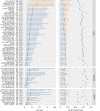When does matriliny fail? The frequencies and causes of transitions to and from matriliny estimated from a de novo coding of a cross-cultural sample
- PMID: 31303165
- PMCID: PMC6664135
- DOI: 10.1098/rstb.2019.0006
When does matriliny fail? The frequencies and causes of transitions to and from matriliny estimated from a de novo coding of a cross-cultural sample
Abstract
The question of when and why societies have transitioned away from matriliny to other types of kinship systems-and when and why they transition towards matriliny-has a long history in anthropology, one that is heavily engaged with both evolutionary theory and cross-cultural research methods. This article presents tabulations from a new coding of ethnographic documents from the Standard Cross-Cultural Sample (SCCS), tallying claims of transitions in kinship systems both away from and to matriliny using various levels of stringency. We then use our counts as the outcome variables in a set of Bayesian analyses that simultaneously estimate the probability of a transition occurring given societal covariates alongside the conditional probability of detecting a transition given the volume of ethnographic data available to code. Our goal is to estimate the cross-cultural and comparative frequency of transitions away from and to matriliny, as well as to explore potential causes underlying these patterns. We find that transitions away from matriliny have been significantly more common than 'reverse transitions' to matriliny. Our evidence suggests that both rates may be, in part, an artefact of the colonial and globalizing period during which the data comprising much of the current ethnographic record were recorded. Analyses of the correlates of transitions away from matriliny are consistent with several of the key causal arguments made by anthropologists over the past century, especially with respect to subsistence transition (to pastoralism, intensive agriculture and market economies), social complexity and colonialism, highlighting the importance of ecological factors in such transitions. This article is part of the theme issue 'The evolution of female-biased kinship in humans and other mammals'.
Keywords: SCCS; cross-cultural research; eHRAF; kinship; matriliny; subsistence.
Conflict of interest statement
We have no competing interests.
Figures


Similar articles
-
The evolution of female-biased kinship in humans and other mammals.Philos Trans R Soc Lond B Biol Sci. 2019 Sep 2;374(1780):20190007. doi: 10.1098/rstb.2019.0007. Epub 2019 Jul 15. Philos Trans R Soc Lond B Biol Sci. 2019. PMID: 31303170 Free PMC article.
-
A worldwide view of matriliny: using cross-cultural analyses to shed light on human kinship systems.Philos Trans R Soc Lond B Biol Sci. 2019 Sep 2;374(1780):20180077. doi: 10.1098/rstb.2018.0077. Epub 2019 Jul 15. Philos Trans R Soc Lond B Biol Sci. 2019. PMID: 31303161 Free PMC article.
-
The expendable male hypothesis.Philos Trans R Soc Lond B Biol Sci. 2019 Sep 2;374(1780):20180080. doi: 10.1098/rstb.2018.0080. Epub 2019 Jul 15. Philos Trans R Soc Lond B Biol Sci. 2019. PMID: 31303164 Free PMC article.
-
How can non-human primates inform evolutionary perspectives on female-biased kinship in humans?Philos Trans R Soc Lond B Biol Sci. 2019 Sep 2;374(1780):20180074. doi: 10.1098/rstb.2018.0074. Epub 2019 Jul 15. Philos Trans R Soc Lond B Biol Sci. 2019. PMID: 31303156 Free PMC article. Review.
-
Gender disparities in material and educational resources differ by kinship system.Philos Trans R Soc Lond B Biol Sci. 2023 Aug 14;378(1883):20220299. doi: 10.1098/rstb.2022.0299. Epub 2023 Jun 26. Philos Trans R Soc Lond B Biol Sci. 2023. PMID: 37381853 Free PMC article. Review.
Cited by
-
The slave trade and the origins of matrilineal kinship.Philos Trans R Soc Lond B Biol Sci. 2024 Mar 11;379(1897):20230032. doi: 10.1098/rstb.2023.0032. Epub 2024 Jan 22. Philos Trans R Soc Lond B Biol Sci. 2024. PMID: 38244605 Free PMC article.
-
The evolution of female-biased kinship in humans and other mammals.Philos Trans R Soc Lond B Biol Sci. 2019 Sep 2;374(1780):20190007. doi: 10.1098/rstb.2019.0007. Epub 2019 Jul 15. Philos Trans R Soc Lond B Biol Sci. 2019. PMID: 31303170 Free PMC article.
-
Patrilineal segmentary systems provide a peaceful explanation for the post-Neolithic Y-chromosome bottleneck.Nat Commun. 2024 Apr 24;15(1):3243. doi: 10.1038/s41467-024-47618-5. Nat Commun. 2024. PMID: 38658560 Free PMC article.
-
A rapid decline in gender bias relates to changes in subsistence practices over demographic changes in a formerly matrilineal community.iScience. 2025 Jan 31;28(2):111926. doi: 10.1016/j.isci.2025.111926. eCollection 2025 Feb 21. iScience. 2025. PMID: 40034119 Free PMC article.
-
Continental influx and pervasive matrilocality in Iron Age Britain.Nature. 2025 Jan;637(8048):1136-1142. doi: 10.1038/s41586-024-08409-6. Epub 2025 Jan 15. Nature. 2025. PMID: 39814899 Free PMC article.
References
-
- Morgan LH. 1877. Ancient society. New York, NY: Henry Holt and Company; See http://www.gutenberg.org/files/45950/45950-h/45950-h.htm
-
- Murdock GP. 1949. Social structure. New York, NY: Macmillan.
-
- Schneider DM. 1961. The distinctive features of matrilineal descent groups. In Matrilineal kinship (eds Schneider DM, Gough K), pp. 1–29. Berkeley, CA: University of California Press.
-
- Stone L. 2014. Kinship and gender: an introduction. New York, NY: Routledge.
-
- Schneider DM, Gough K. 1961. Matrilineal kinship. Berkeley, CA: University of California Press.
MeSH terms
Associated data
LinkOut - more resources
Full Text Sources
Miscellaneous

